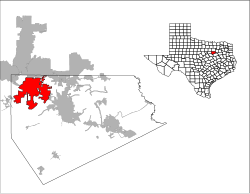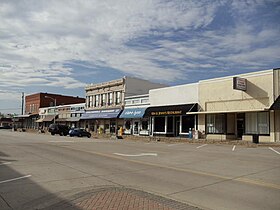Midlothian, Texas
Midlothian, Texas | |
|---|---|
 Location of Midlothian, Texas | |
 | |
| Country | |
| State | |
| County | Ellis City Type: Rural/City |
| Government | |
| • Type | Council-Manager |
| • City Council | Mayor Bill Houston Wayne Sibley Mike Rodgers Jimmie L. McClure Joe Frizzell T. J. Henley Ted Miller |
| • City Manager | Don Hastings |
| Area | |
| • Total | 37.9 sq mi (98.1 km2) |
| • Land | 37.7 sq mi (97.7 km2) |
| • Water | 0.2 sq mi (0.5 km2) |
| Elevation | 755 ft (230 m) |
| Population (2000) | |
| • Total | 7,480 |
| • Density | 198.4/sq mi (76.6/km2) |
| Time zone | UTC-6 (Central (CST)) |
| • Summer (DST) | UTC-5 (CDT) |
| ZIP code | 76065 |
| Area code | 972 |
| FIPS code | 48-48096Template:GR |
| GNIS feature ID | 1341552Template:GR |
| Website | midlothian.tx.us |


Midlothian is a city in northwest Ellis County, Texas, United States. It is the hub for the cement industry in North Texas as it is the home to three separate cement production facilities, as well as a steel mill. Midlothian is also a fast growing community with a growth rate of 142% since 2000. The population was 18,037 at the 2010 census.
Geography
Midlothian is located at 32°28′49″N 96°59′22″W / 32.48028°N 96.98944°W (32.480169, -96.989350)Template:GR.
Adjacent cities are Cedar Hill to the north, Grand Prairie to the northwest, Venus to the southwest, Waxahachie to the southeast, and Ovilla to the northeast.
According to the United States Census Bureau, the city has a total area of 98.1 km2 (37.9 sq mi), of which 37.7 square miles (98 km2) is land and 0.2 square miles (0.52 km2) (0.50%) is water. Midlothian's extraterritorial jurisdiction includes another 33 square miles (85 km2).[citation needed]
Demographics
As of the 2010 census the population density was 362.5 people per square mile (76.6/km²), a total population of 18,037 people. There were 6,138 housing units at an average density of 74.0 per square mile (28.6/km²). The racial makeup of the city was 88.5% White, 3.6% African American, 0.4% Native American, 0.8% Asian, 0.1% Pacific Islander, 4.2% from other races, and 2.4% from two or more races. Hispanic or Latino of any race were 15.2% of the pn.
There were 4,963 households out of which 46.0% had children under the age of 18 living with them, 63.1% were married couples living together, 12.7% had a female householder with no husband present, and 19.1% were non-families. 15.5% of all households were made up of individuals and 4.7% had someone living alone who was 65 years of age or older. The average household size was 2.94 and the average family size was 3.26.
In the city, the population was spread out with 34.1% under the age of 19, 5.2% from 20 to 24, 30.1% from 25 to 44, 22.7% from 45 to 64, and 7.7% who were 65 years of age or older. The median age was 32.1 years. For every 100 females there were 96.6 males.
As of the 2000 census the median income for a household in the city was $49,464, and the median income for a family was $55,055. Males had a median income of $37,151 versus $27,209 for females. The per capita income for the city was $19,329. About 4.4% of families and 6.3% of the population were below the poverty line, including 8.2% of those under age 18 and 8.0% of those age 65 or over.
Government
The City of Midlothian was incorporated in 1888 and on October 1, 1980 the city was granted a home-rule charter. Midlothian uses a council-manager form of government. The City Council is composed of a mayor and six at-large council members elected by the citizenry.
Economy
Prior to 1929 and the Great Depression, a number of businesses flourished in the city. The two largest business enterprises centered around cotton and cattle-raising. The region was transformed in later years by the arrival of the cement industry. Midlothian became a prime area for cement quarrying due to the Austin Chalk Escarpment, a unique geological formation that runs north-south through the City. Three of the top ten largest cement factories in the United States operate in the city: Texas Industries ("TXI"), Holcim and Ash Grove. Gerdau Ameristeel, formerly Chaparral Steel, a large steel factory is adjacent to TXI's cement plant.
A large industrial park, Railport, is located along U.S. 67 on the southwestern side of the city. Railport is home to several distribution facilities including Target, Toys R US, and QuikTrip.
The north side of the city is also host to MidTexas International Center’s Auto Park, a large automobile distribution and processing center; and Texas Central Business Lines, a rail transload facility.
Top employers
According to Midlothian's 2010 Comprehensive Annual Financial Report,[1] the top employers in the city are:
| # | Employer | # of Employees |
|---|---|---|
| 1 | Midlothian Independent School District | 933 |
| 2 | Gerdau Ameristeel | 832 |
| 3 | Target| | 600 |
| 4 | Walmart | 400 |
| 5 | Toys "R" Us | 300 |
| 6 | City of Midlothian | 197 |
| 7 | Texas Industries | 174 |
| 8 | Holcim | 170 |
| 9 | Navarro College | 80 |
| 10 | MidTexas International Center | 75 |
Education
Primary Education
Primary education for the community is provided by the Midlothian Independent School District (MISD) which encompasses an area of approximately 112 square miles. MISD conducts programs for Kindergarten through grade 12 and employs approximately 850 employees. MISD has nine school campuses with 461 teachers and an enrollment of 7,564 for the 2013-2013 school year. The student to teacher ratio is 16 to 1.
MISD students have historically excelled in a number of extracurricular activities. Midlothian High School, called the "Panthers", students have been awarded numerous times in Agricultural, Problem Solvers competitions, and high quality music organizations. The Midlothian High School baseball, soccer, and softball teams are often seen in the 4A playoff bracket. A $14,000,000 multi-purpose athletic stadium was constructed in 2006.
Midlothian had two National Merit Finalists in 2006, 2007 and 2008.
Higher Education
Higher education opportunities are also readily available in Midlothian. On April 25, 2012 the Texas Higher Education Coordinating Board approved the establishment of a multi-institutional teaching center (MITC) in Midlothian known as the Midlothian Higher Education Center (MHEC). As one of only nine MITC's in Texas, the MHEC is a partnership consisting of Navarro College-Midlothian, Tarleton State University, Texas A&M University-Commerce and the University of North Texas-Dallas. The collaboration between the four institutions provide Ellis County area students the ability to complete baccalaureate and graduate degree programs at Navarro College's Midlothian Campus.
Transportation
Midlothian is strategically located at the juncture of U.S. Highway 67 and U.S. Highway 287. The City's location provides easy access to an important ground transportation network consisting of interstates, U.S. highways and state highways that connect Dallas, Fort Worth, the Metroplex and the state.
MidWay Regional Airport
Located three miles east of Midlothian is MidWay Regional Airport (JWY). Jointly operated by the cities of Midlothian and Waxahachie, MidWay Regional Airport is a 320-acre corporate and general aviation airport. It is a full-service FBO offering maintenance, repair, rental, sales, servicing, flight planning, computerized weather, UNICOM, RCO and AWOS. The airport opened in October 1992 to serve a rapidly growing area. An expansion project completed in January 2012 included a major terminal renovation.


